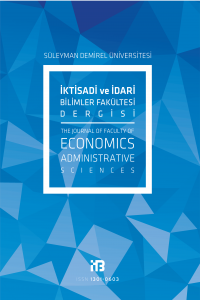GİZLİ MÜŞTERİ ARAŞTIRMASI: MOBİLYA SEKTÖRÜNDE BİR UYGULAMA
Gizli Müşteri, Gizli Alışverişçi, Gizli Müşteri Araştırması, Gizli Alışveriş, Araştırma, Hizmet Kalitesi
Gizli Müşteri Araştırması: Mobilya Sektöründe Bir Uygulama
-,
___
- 1. Argouslidis, P.C. and McLean, F. (2004), “Service Elimination Decision-Making: The Identification of Financial Services as Candidates for Elimination”, European Journal of Marketing, Vol. 38, No. 11/12, pp. 1355-1381.
- 2. Bowers, M.R. and Martin, C.L. (2007), “Trading Places Redux: Employees As Customers, Customers As Employees”, Journal of Services Marketing, Vol. 21, No. 2, pp. 88–98.
- 3. Calvert, P. (2005), “It’s a Mystery: Mystery Shopping in New Zealand’s Public Libraries”, Library Review, Vol. 54, No. 1, pp. 24-35.
- 4. Clark, P. (2002), “Mystery Shopping as a Way to Earn Cash”, WebWatch, July/August, pp. 18-19.
- 5. Erstad, M. (1998), “Mystery Shopping Programmes and Human Resource Management”, International Journal of Contemporary Hospitality Management, Vol. 10, No. 1, pp. 34–38.
- 6. Finn A. and Kayande, U. (1999), “Unmasking a Phantom: A Psychometric Assessment of Mystery Shopping”, Journal of Retailing, Vol. 75, No. 2, pp. 195–217.
- 7. Goodwin, E. (2006), “Shopping for a Mystery Shopper”, Restaurant Hospitality, August, pp. 80-82.
- 8. Gosselt, J.F.; Hoof, J.J.V.; Jong, M.D.T.D. and Prinsen, S. (2007), “Mystery Shopping and Alcohol Sales: Do Supermarkets and Liquor Stores Sell Alcohol to Underage Customers?”, Journal of Adolescent Health, Vol. 41, pp. 302–308.
- 9. Hemedoğlu, E.; Durman, İ. ve Kurt, T. (2008), “Toplu Taşımacılık Sektöründe Performans Ölçüm Aracı Olarak Gizli Müşteri Araştırmaları”, İstanbul Büyükşehir Belediyesi Kentiçi Raylı Sistemler Teknik, Eğitim, Kültür Bülteni, Nisan-Mayıs-Haziran, Sayı 9, ss. 2–11.
- 10. Hesselink, M. and Wiele, T.V.D. (2003), “Mystery Shopping: In-depth Measurement of Customer Satisfaction” Erasmus Research Institute of Management (ERIM), Rotterdam School of Management and Rotterdam School of Economics, Rotterdam, ERIM Report Series Reference Number: ERS-2003-020-ORG, March, pp. 1-12.
- 11. Hudson, S.; Snaith, T.; Miller, G.A. and Hudson, P. (2001), “Distribution Channels in the Travel Industry: Using Mystery Shoppers to Understand the Influence of Travel Agency Recommendations”, Journal of Travel Research, Vol. 40, pp. 148-154.
- 12. McGregor, F. (2005), “Exploring the Mystery of Service Satisfaction”, Academic Services Division – Papers, Proceedings of the 6th Northumbria International Conference on Performance Measurement in Libraries and Information Services, Durham, England, 22-25 August, pp. 1-8.
- 13. Morrison, L. J.; Colman, A.M. and Preston, C.C. (1997), “Mystery Customer Research: Cognitive Processes Affecting Accuracy”, Journal of Market Research Society, Vol. 39, No. 2, pp. 349-361.
- 14. Norris, P. (2004), “Reasons Why Mystery Shopping is a Useful and Justifiable Research Method”, The Pharmaceutical Journal, Vol. 272, No. 12, pp. 746-747.
- 15. Shing, M.N.K. and Spence, L.J. (2002), “Investigating The Limits of Competitive Intelligence Gathering: Is Mystery Shopping Ethical?”, Business Ethics: A European Review, Vol.11, No. 4, pp. 343-353.
- 16. Thornley, T.; Gray, N.; Anderson, C. and Eastham, S. (2006), “A study to investigate the extent of delivery of an intervention in asthma, in a UK national community pharmacy chain, using mystery customers”, Patient Education and Counseling, Vol. 60, pp. 246–252.
- 17. Wiele, T.V.D.; Hesselink, M. and Iwaarden, J.V. (2005), “Mystery Shopping: A Tool to Develop Insight into Customer Service Provision” Total Quality Management, Vol. 16, No. 4, pp. 529–541.
- 18. Wilson, A.M. (1998a) “The Role of Mystery Shopping in The Measurement of Service Performance” Managing Service Quality, Vol. 8, No. 6, pp. 414–420.
- 19. Wilson, A.M., (1998b) “The Use of Mystery Shopping in The Measurement of Service Performance” The Service Industries Journal, Vol. 18, No. 3, pp. 148-163.
- 20. Wilson, A.M. and Gutmann, J. (Oct 1998), “Public transport: The Role of Mystery Shopping in Investment Decisions”, Journal of the Market Research Society; Vol. 40, No. 4, pp. 285-293.
- 21. Wilson, A.M., (July 2001), “Mystery Shopping: Using Deception to Measure Service Performance”, Psychology & Marketing, Vol. 18, No. 7, pp. 721–734.
- 22. Wilson, A.M. (2002),“Attitudes towards Customer Satisfaction Measurement in The Retail Sector”, International Journal of Market Research, Vol. 44, No. 2, pp. 213–248.
- ISSN: 1301-0603
- Yayın Aralığı: Yılda 3 Sayı
- Başlangıç: 1996
- Yayıncı: Süleyman Demirel Üniversitesi
KÜRESELLEŞMENİN VERGİ POLİTİKALARI ÜZERİNDEKİ ETKİNSİZLİK ETKİSİ
Doç.Dr.Nihal KARGI, Doç.Dr.Ekrem KARAYILMAZLAR
MARKA SADAKATİ ÖNCÜLLERİ: ÇALIŞAN KADINLARIN KOZMETİK ÜRÜN TÜKETİMİ ÜZERİNE BİR ÇALIŞMA
Öğr.Gör.Dr.Tülay Korkmaz DEVRANİ
REKABET ÜSTÜNLÜĞÜNÜN SÜRDÜRÜLMESİNDE YETENEKLERİN ROLÜ: YETENEK YÖNETİM YAKLAŞIMI
ULUSAL İNOVASYON POLİTİKALARI VE KAMU HARCAMALARI: ÇEŞİTLİ ÜLKELER ÜZERİNE BİR KARŞILAŞTIRMA
Yrd.Doç.Dr.Ali YAVUZ, Doç.Dr.Mesut ALBENİ, Arş.Gör.Dilek GÖZE KAYA
DEVLETİN DEĞİŞİM SÜRECİNDE BELEDİYELERİN KONUT POLİTİKALARINDA FARKLILAŞAN ROLÜ
Yrd.Doç.Dr.Mithat Arman KARASU
FİNANSAL BİLGİ SİSTEMİNİN HİSSE SENETLERİNE YATIRIM KARARI ÜZERİNE ETKİSİ: İMKB’de Bir Uygulama
Doç.Dr.İsmail BEKÇİ, Havva ALKAN
İŞ YOĞUNLUĞU TAHMİNİ ve İŞGÜCÜ PLANLAMA: SÜPERMARKET UYGULAMASI
Yrd.Doç.Dr.Ecir Uğur KÜÇÜKSİLLE, Prof.Dr.İbrahim GÜNGÖR
LİTERATÜR ARAŞTIRMASI: ALTI SİGMA METODOLOJİSİ
Yrd.Doç.Dr.Ediz ATMACA, S.Şule GİRENES
Doç.Dr.Şeref KALAYCI, Esra ZEYNEL
